Abstract
The effect of various manipulations of liposomes composed of equimolar phospholipid and cholesterol on immune responses to the incorporated immunopurified tetanus toxoid was investigated in BALB/c mice. In studies designed to establish proper dosage for immunization and to reveal the roles of the liposomal phospholipid to toxoid mass ratio, gel-liquid crystalline transition temperatures (Tc) of the liposomal phospholipids and mode of antigen incorporation into liposomes on immune responses, animals were injected intramuscularly with various amounts of the toxoid, free, entrapped in multilamellar dehydration-rehydration vesicles (DRV) or covalently linked to the surface of multilamellar vesicles (MLV) prepared by the classical procedure. Two identical injections separated by 4 weeks were given and IgG1 and IgG2b antibodies specific for the toxoid assayed in sera by an enzyme-linked immunosorbent assay. Results suggest that the adjuvant effect of liposomes is improved considerably when liposomal phospholipid to toxoid mass ratios are as high as 2049:1; however, adjuvanticity is reduced to reach very low levels for much higher ratios (e.g. 90,361:1); antibody responses are similar for liposomes (phospholipid to toxoid mass ratios: 14.3-33.1) made of a variety of phospholipids with Tcs ranging from -32 degrees to 41.5 degrees but are low or non-existent when liposomes are made of distearoyl phosphatidylcholine (Tc, 54 degrees) (however, see Discussion); there are no differences in antibody responses between liposomes with entrapped and surface-linked toxoid.
Full text
PDF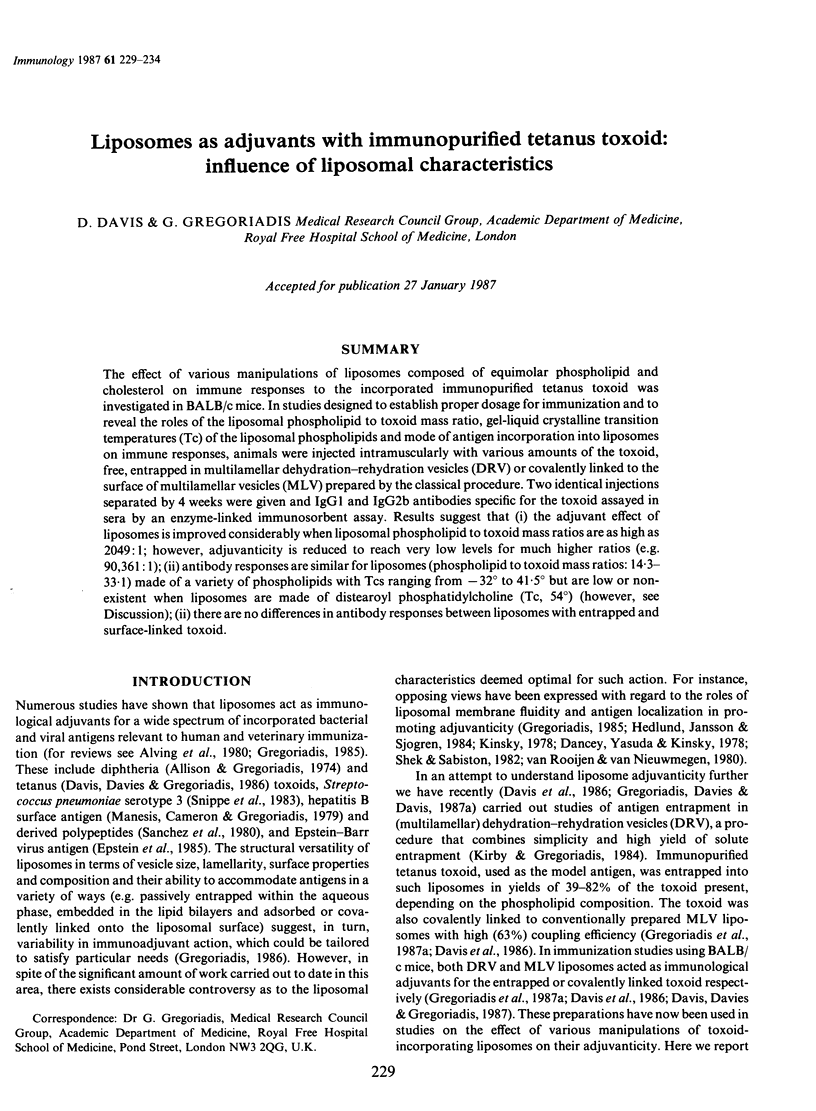
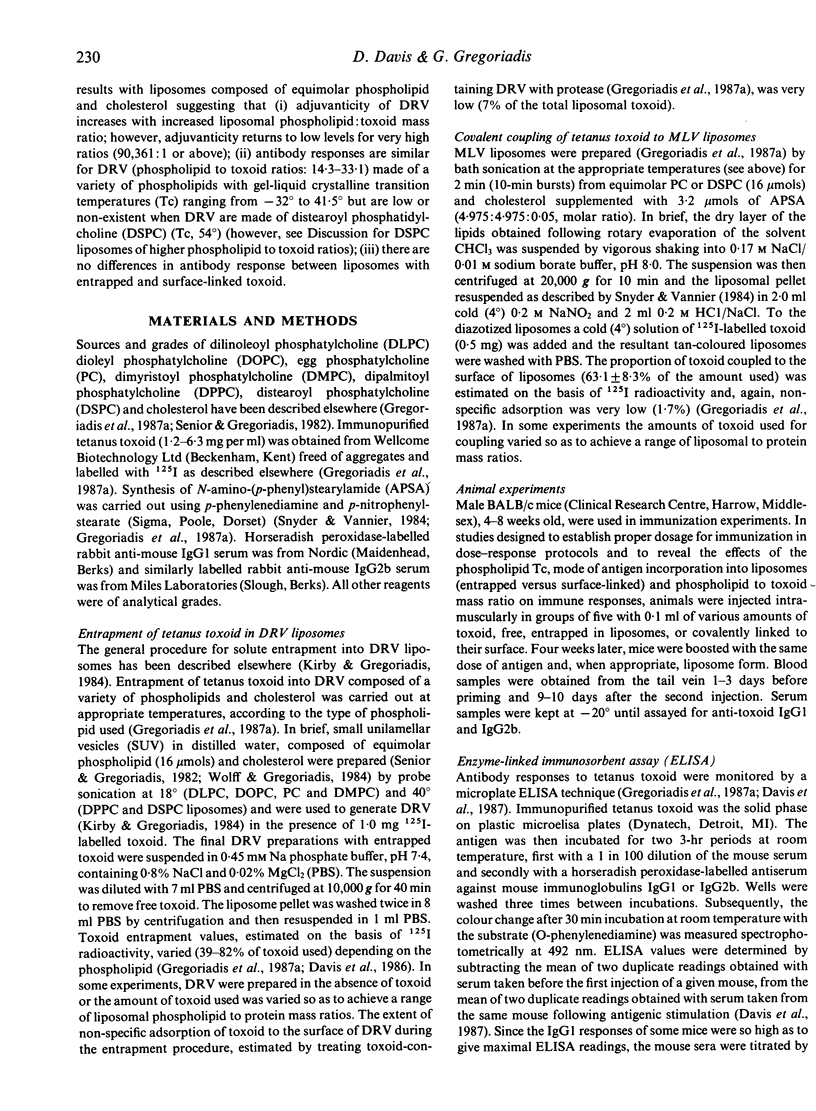

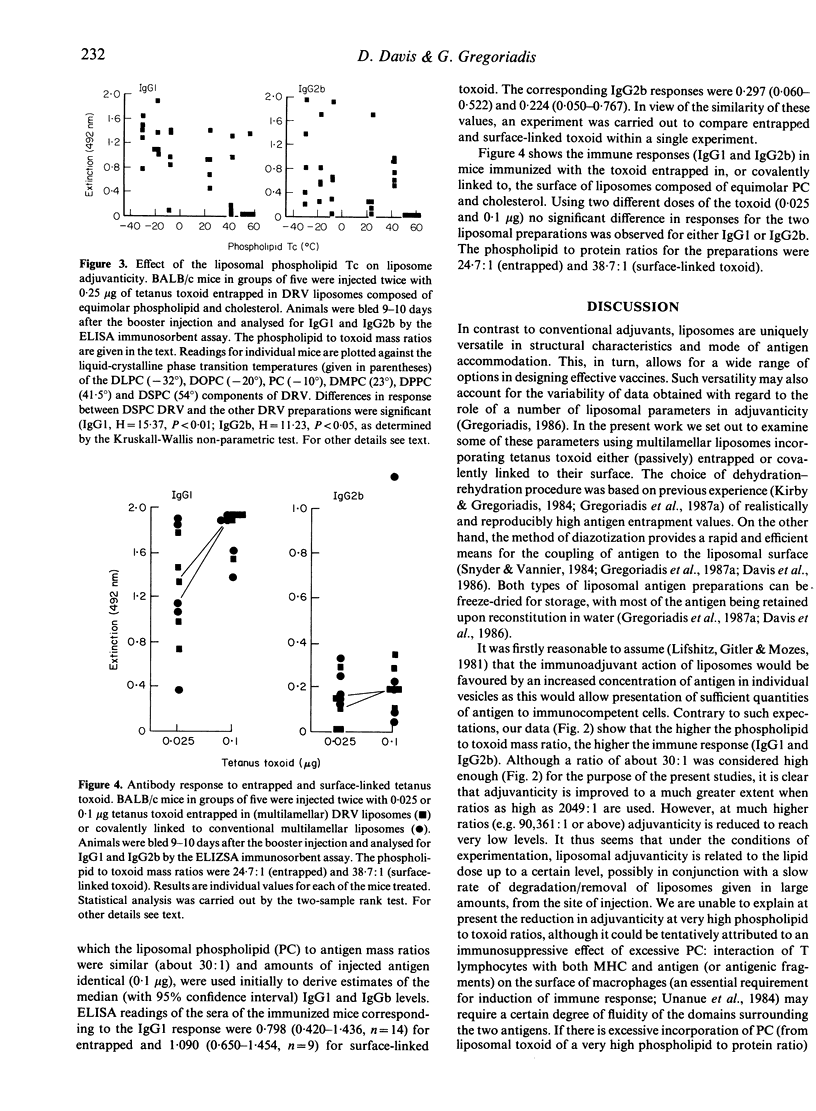
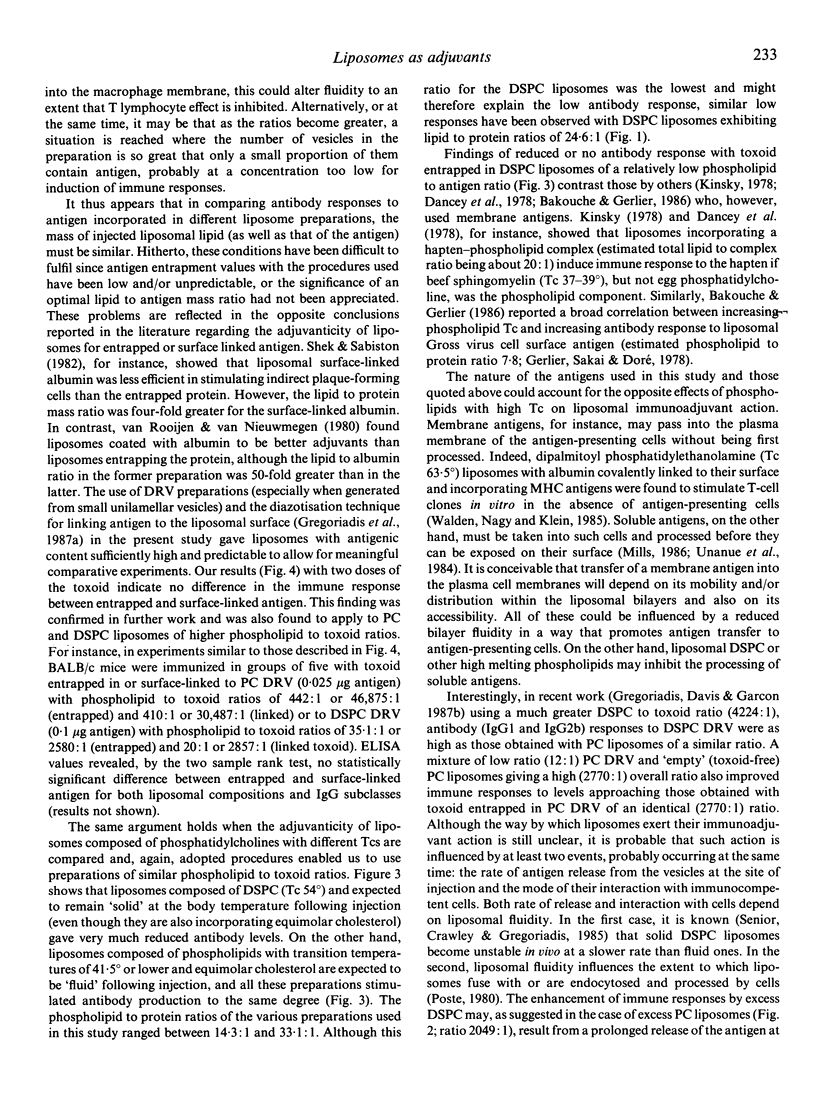
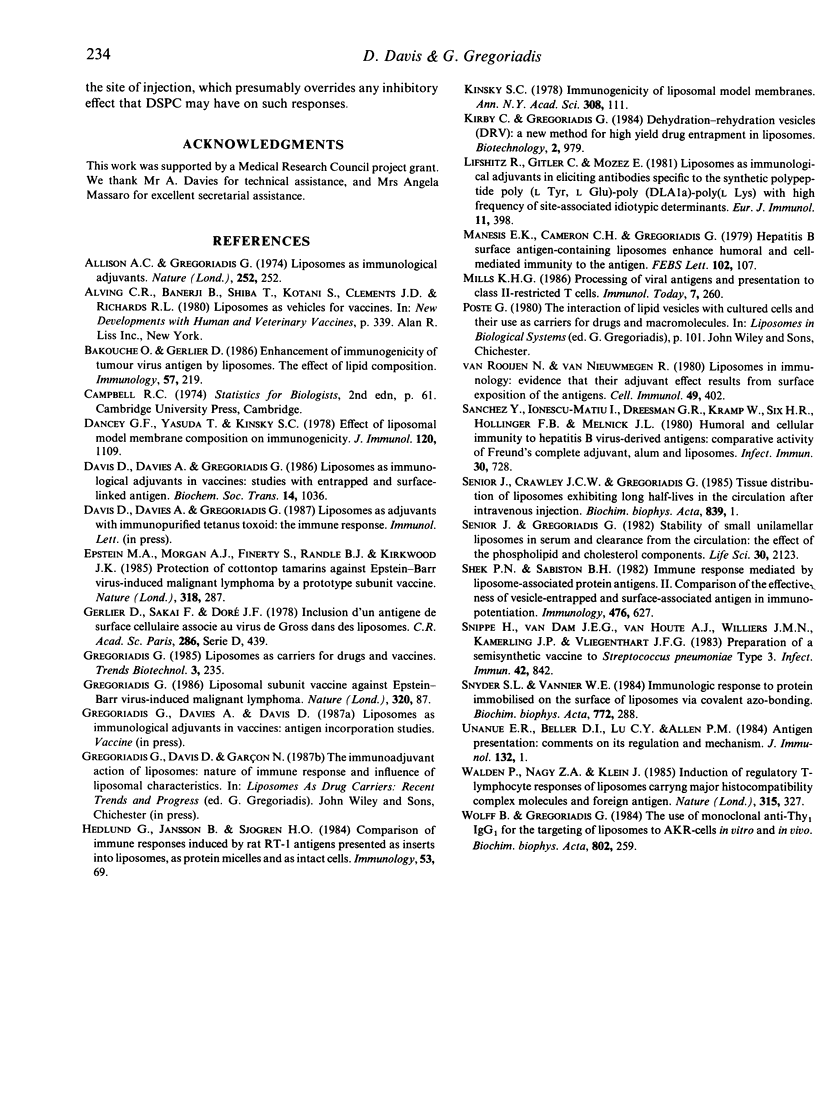
Selected References
These references are in PubMed. This may not be the complete list of references from this article.
- Allison A. G., Gregoriadis G. Liposomes as immunological adjuvants. Nature. 1974 Nov 15;252(5480):252–252. doi: 10.1038/252252a0. [DOI] [PubMed] [Google Scholar]
- Alving C. R., Banerji B., Shiba T., Kotani S., Clements J. D., Richards R. L. Liposomes as vehicles for vaccines. Prog Clin Biol Res. 1980;47:339–355. [PubMed] [Google Scholar]
- Bakouche O., Gerlier D. Presentation of an MuLV-related tumour antigen in liposomes as a potent tertiary immunogen after adoptive transfer. Immunology. 1986 Feb;57(2):219–223. [PMC free article] [PubMed] [Google Scholar]
- Dancey G. F., Yasuda T., Kinsky S. C. Effect of liposomal model membrane composition on immunogenicity. J Immunol. 1978 Apr;120(4):1109–1113. [PubMed] [Google Scholar]
- Epstein M. A., Morgan A. J., Finerty S., Randle B. J., Kirkwood J. K. Protection of cottontop tamarins against Epstein-Barr virus-induced malignant lymphoma by a prototype subunit vaccine. Nature. 1985 Nov 21;318(6043):287–289. doi: 10.1038/318287a0. [DOI] [PubMed] [Google Scholar]
- Gerlier D., Sakai F., Doré J. F. Inclusion d'un antigène de surface cellulaire associé au virus de Gross dans des liposomes. C R Acad Sci Hebd Seances Acad Sci D. 1978 Feb 6;286(5):439–442. [PubMed] [Google Scholar]
- Kinsky S. C. Immunogenicity of liposomal model membranes. Ann N Y Acad Sci. 1978;308:111–123. doi: 10.1111/j.1749-6632.1978.tb22017.x. [DOI] [PubMed] [Google Scholar]
- Lifshitz R., Gitler C., Mozes E. Liposomes as immunological adjuvants in eliciting antibodies specific to the synthetic polypeptide poly(LTyr, LGlu)-poly(DLAla)--(LLys) with high frequency of site-associated idiotypic determinants. Eur J Immunol. 1981 May;11(5):398–404. doi: 10.1002/eji.1830110510. [DOI] [PubMed] [Google Scholar]
- Manesis E. K., Cameron C. H., Gregoriadis G. Hepatitis B surface antigen-containing liposomes enhance humoral and cell-mediated immunity to the antigen. FEBS Lett. 1979 Jun 1;102(1):107–111. doi: 10.1016/0014-5793(79)80939-4. [DOI] [PubMed] [Google Scholar]
- Sanchez Y., Ionescu-Matiu I., Dreesman G. R., Kramp W., Six H. R., Hollinger F. B., Melnick J. L. Humoral and cellular immunity to hepatitis B virus-derived antigens: comparative activity of Freund complete adjuvant alum, and liposomes. Infect Immun. 1980 Dec;30(3):728–733. doi: 10.1128/iai.30.3.728-733.1980. [DOI] [PMC free article] [PubMed] [Google Scholar]
- Senior J., Gregoriadis G. Stability of small unilamellar liposomes in serum and clearance from the circulation: the effect of the phospholipid and cholesterol components. Life Sci. 1982 Jun 14;30(24):2123–2136. doi: 10.1016/0024-3205(82)90455-6. [DOI] [PubMed] [Google Scholar]
- Shek P. N., Sabiston B. H. Immune response mediated by liposome-associated protein antigens. II. Comparison of the effectiveness of vesicle-entrapped and surface-associated antigen in immunopotentiation. Immunology. 1982 Dec;47(4):627–632. [PMC free article] [PubMed] [Google Scholar]
- Snippe H., van Dam J. E., van Houte A. J., Willers J. M., Kamerling J. P., Vliegenthart J. F. Preparation of a semisynthetic vaccine to Streptococcus pneumoniae type 3. Infect Immun. 1983 Nov;42(2):842–844. doi: 10.1128/iai.42.2.842-844.1983. [DOI] [PMC free article] [PubMed] [Google Scholar]
- Snyder S. L., Vannier W. E. Immunologic response to protein immobilized on the surface of liposomes via covalent azo-bonding. Biochim Biophys Acta. 1984 May 30;772(3):288–294. doi: 10.1016/0005-2736(84)90145-7. [DOI] [PubMed] [Google Scholar]
- Walden P., Nagy Z. A., Klein J. Induction of regulatory T-lymphocyte responses by liposomes carrying major histocompatibility complex molecules and foreign antigen. Nature. 1985 May 23;315(6017):327–329. doi: 10.1038/315327a0. [DOI] [PubMed] [Google Scholar]
- Wolff B., Gregoriadis G. The use of monoclonal anti-Thy1 IgG1 for the targeting of liposomes to AKR-A cells in vitro and in vivo. Biochim Biophys Acta. 1984 Nov 28;802(2):259–273. doi: 10.1016/0304-4165(84)90170-3. [DOI] [PubMed] [Google Scholar]
- van Rooijen N., van Nieuwmegen R. Liposomes in immunology: evidence that their adjuvant effect results from surface exposition of the antigens. Cell Immunol. 1980 Feb;49(2):402–407. doi: 10.1016/0008-8749(80)90043-x. [DOI] [PubMed] [Google Scholar]


